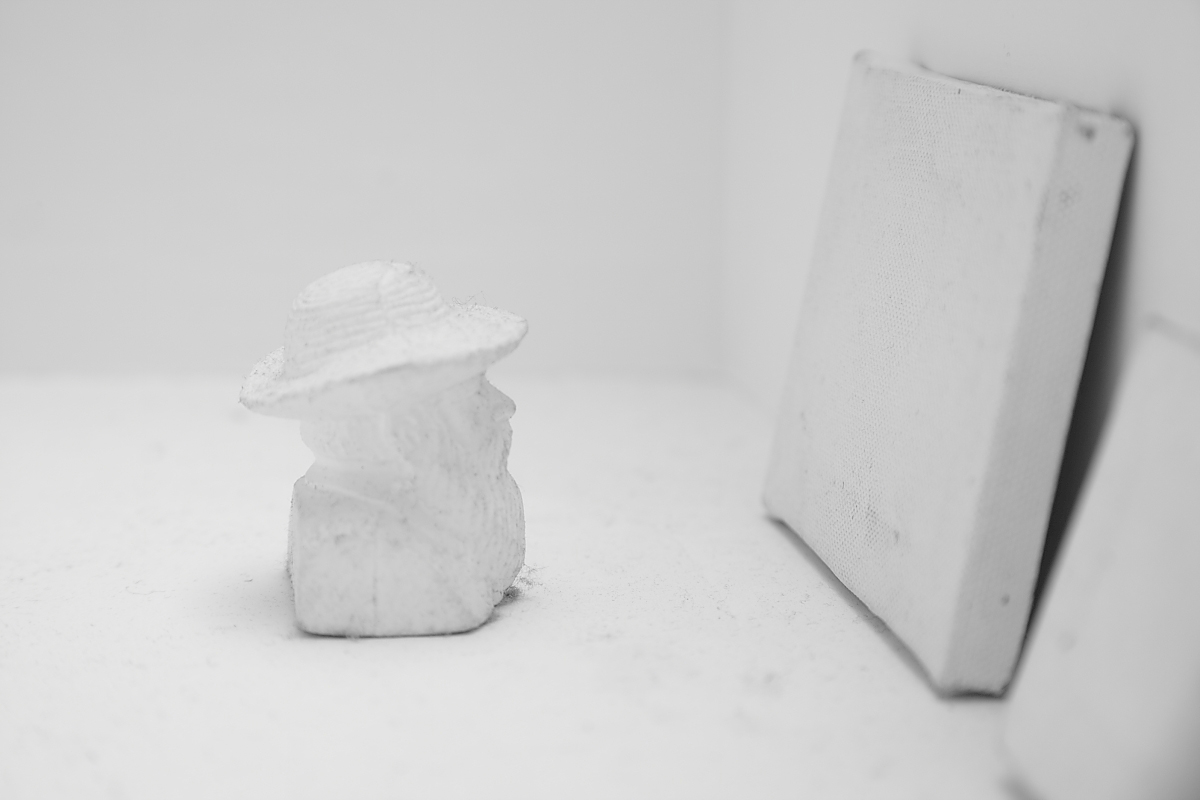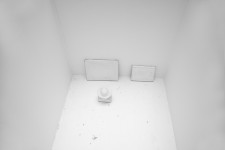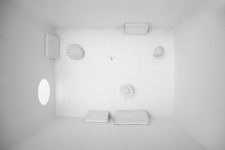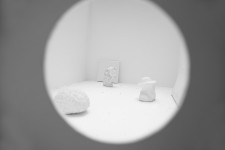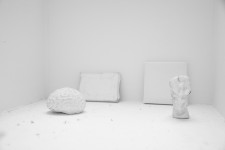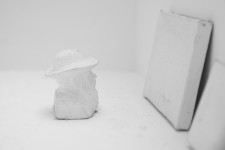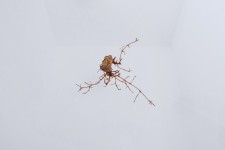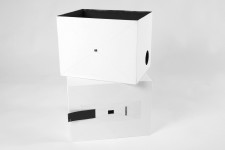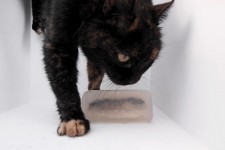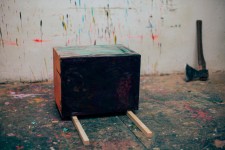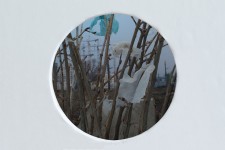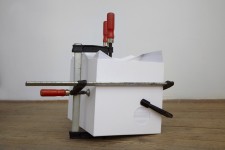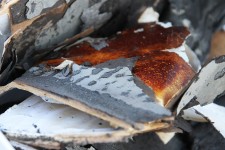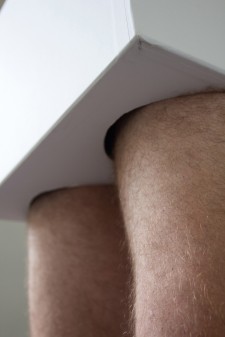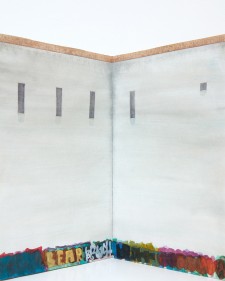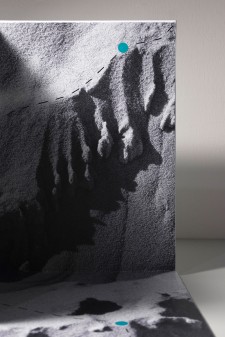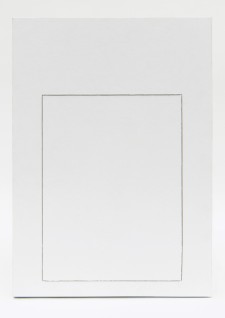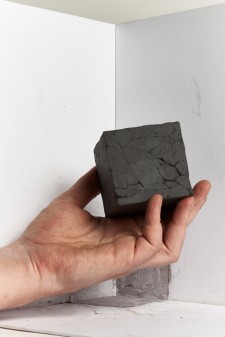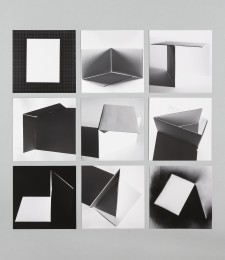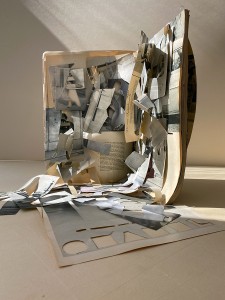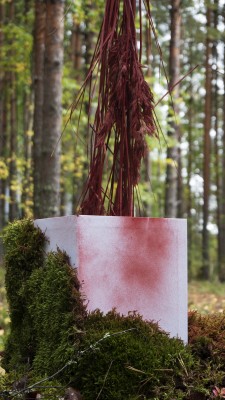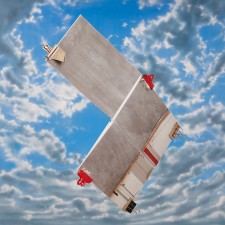Karine Fauchard let the Paper Museum turn into a dusty white cell. Over the past few months, dust particles have been collecting in the exhibition space. Dirt from the city of Vienna gives the white objects within visual depth. White rooms are closely tied to the idea of modernity. Brian OãDoherty described a white room as a space that keeps out anything that might distract from the art within. Inside this space, even a standing ashtray becomes a sacred object. ãIn actuality, the object often serves as a medium through which these ideas are expressed and offered up for discussion ã a popular form of academia in late modernity (ãIdeas are more important than works of artã)ã.[1]
Karine Fauchardãs objects are things from the museum shop. Knick-knacks that represent paintings and sculptures. A mini-model canvas frame of Manet, a three-centimeter-tall ãsculptureã of Rodinãs Thinker, a bust of Cezanne, and a brain by Hirst. Only these are not plaster casts, as one would first think, but erasers in the shapes created by the old and new masters. These erasers slowly lose their form through the process of erasing. The changing or erasing of a pencil drawing would cause Karineãs sculptures to become abstract egg-shaped objects. She uses the museum shop Knick-knacks to spotlight the conditions art is produced under. Hirst, a new master on the art market, and old masters Cezanne, Manet, and Rodin are part of the structure within which each new generation of art is defined. Where can the starting point of art be found? With the producers themselves! The painter looks at the white canvas, at the white page of a sketchbook, or a model of the next exhibition space and sometimes a white panic creeps in, questioning whether the idea, the concept, the creation will withstand scrutiny: White Panic.
[1] Brian OôÇDoherty: Inside the White Cube, In der weiûen Zelle. Berlin, Merve,1996.
ã
Karine Fauchard lieû das Paper Museum zu einer verstaubten weiûe Zelle werden. Im Ausstellungsraum sammelten sich û¥ber die letzen Monate Staubpartikel. Dreck der Stadt Wien, der den darin befindlichen weiûen Objekten optische Tiefe verleiht. Der weiûe Raum ist eng verbunden mit den Ideen der Moderne. Brian OôÇDoherty beschrieb ihn als Raum, der alles abhûÊlt, was vom Kunstwerk ablenkt. In ihm wird sogar der Standaschenbecher zum sakralen Kultobjekt. ãIn der Tat dient der Gegenstand hûÊufig nur als Medium, durch das sich diese Ideen kundtun und der Diskussion anbieten – eine populûÊre Form des Akademismus der spûÊten Moderne (ãIdeen sind wichtiger als Kunstwerkeã)ã[1]
Karine Fauchards Objekte sind Dinge aus dem Museumsshop. Nippes, der Malerei und Skulptur reprûÊsentiert. Treffenderweise heiût der Verkaufsartikel der Mini-Modellkeilrahmen ãManetã, die ãPlastikenã zeigen Rodins Denker in einer HûÑhe von ca. 3 cm, eine Bû¥ste von Cezanne und ein Hirn von Hirst. Nur sind es keine Gipsabgû¥sse, wie zunûÊchst erwartet, sondern Radiergummis in Form der alten und neuen Meister. Durch den Prozess des Radierens verlieren die Figuren ihre Form. Durch die VerûÊnderung oder AuslûÑschung einer Bleistiftzeichnung wû¥rden Karines Plastiken zu eierfûÑrmigen abstrahierten Objekten werden. Sie spielt mit dem Krims Krams aus dem Museumsshop auf die Bedingungen der Kunstproduktion an. Hirst, der neue Meister des Kunstmarkts, Cezanne, Manet und Rodin als alte Meister sind Teil des Gefû¥ges, in dem jede Generation aufs Neue Kunst definiert. Wo ist der Ausgangspunkt der Kunst zu suchen? Bei den Produzenten und Produzentinnen!? Hier blickt die Malerin auf die weiûe Leinwand, auf die weiûe Seite des Skizzenbuchs, oder in ein Modell des Raums fû¥r die nûÊchste Ausstellung und es stellt sich das ein oder andere Mal die weiûe Panik ein, ob die Idee, das Konzept und die Umsetzung standhalten wird: White Panic.
[1] Brian OôÇDoherty: Inside the White Cube, In der weiûen Zelle. Berlin, Merve,1996.
ã ã
